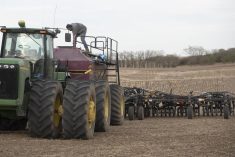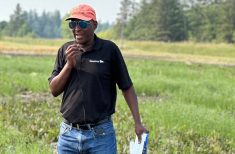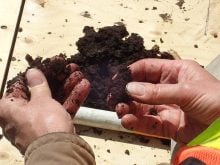Manitoba lags other regions in adopting precision soil sampling, says a representative from a popular lab service.
John Brecker, soil scientist at Agvise Laboratories in North Dakota, says Manitoba’s soil testing trends echo what he sees in his state. About half the samples processed from both North Dakota and Manitoba are feeding into precision systems.
“But in other areas, like South Dakota, Minnesota, or even Saskatchewan, about 80 per cent of the soil samples that we receive are precision soil samples,” he said.
Read Also

Manitoba boosts stake in cereals centre to $23.5 million
Premier Wab Kinew said the additional project funds will help ‘Trump-proof’ the provincial economy.
Why it matters: Precision soil sampling increased with precision ag technology like variable rate, which required deeper data to help farmers efficiently manage inputs.
Even those numbers overstate the amount of precision sampling in the province, he noted. His estimate of 50 per cent refers to total number of samples, not the number of fields serviced. He estimated that closer to 20 per cent of his clients’ fields are getting precision treatment.
His estimates range from a virtually non-existent precision sampling clientele in eastern Manitoba to 86 per cent around Roblin.
Brecker spoke to farmers and agronomists at the Aug. 1 EMILI (Enterprise Machine Intelligence and Learning Initiative) 4R Field Day in Grosse Isle, Man.
Geography helps explain the regional disparities, he said.
“Probably the easiest sell for precision soil sampling is topography. When you get farther west, you start to get some more topography. You get eroded hilltops and you’ve got some low-lying depressions and potholes that are poorly drained. It’s a lot easier to make that visual case for precision soil sampling.”
The Red River Valley, in contrast, is often perceived as flat and lacking variation. That’s a misconception, according to Brecker.
“Anybody who’s looked at a yield monitor in a combine sees very well how those yields vary from one side of the field to the other. That yield monitor data is a strong argument for zone sampling, and those yield differences are going to affect soil nutrients from year to year.”
Outside of topography, weather conditions each year have huge impact on residual nitrogen, regardless of region. Brecker cited the drought of 2021, which saw poor yields across the entire Great Plains region of North America.
“It was the worst drought that the greater region had experienced since the late ‘80s,” he said.
The drought contributed to unusually high residual nitrogen. It was twice what would be expected in a normal year in canola and wheat acres.
“The amount of residual nitrogen was about 66 to 65 pounds on average after either wheat or canola crop that year,” said Brecker. “That is much more than the long-term average of about 25 to 35 pounds you typically would see.”
Given the dry conditions, a farmer could have predicted some residual nitrogen, but not how much. By the start of the 2022 crop year (which started wet), soil sampling showed that much of the nutrient had moved down the soil profile, in many places lingering six to 24 inches deep.
Last year was a different story.
“Last year was also a dry year, but it was kind of a weird year,” said Brecker. “If you look at the wheat data versus the canola data, the wheat data had 51 pounds of residual nitrogen, but canola was only 36 pounds, or much closer to average.”
Weather patterns caused the difference, he added.
“We had a big difference in temperature last year. May and June were extremely hot, but it cooled off in July, and we had great flowering conditions for canola.”
That translated to tremendous canola yields that used more nitrogen. The remaining nutrient would be hard to predict, he said.
“That’s why we soil test every fall, to really try to point out how these environmental factors that we can’t really predict are going to show up. When you do that in a zone system, you can have a lot more confidence behind that data in how you’re going to manage that field.”
















